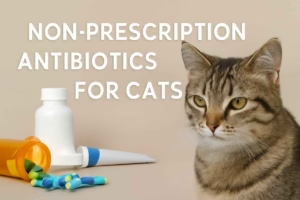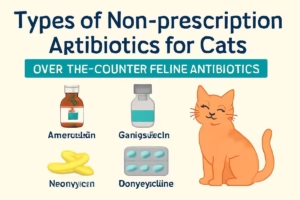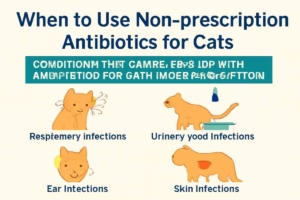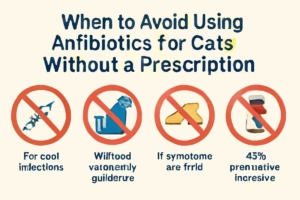As a cat owner, encountering a minor injury or infection in your feline friend is quite common. Whether it’s a small cut, a mild skin infection, or a bit of conjunctivitis in their eyes, the idea of being able to treat these issues without going to the vet can be very appealing. Non-prescription antibiotics for cats have gained popularity as an accessible solution, but it’s important to understand when and how to use them safely.For example, overuse of antibiotics can result in the development of resistant bacteria, which makes future infections harder to treat.
In this blog post, we’ll explore everything you need to know about non-prescription antibiotics for cats, from the types available to the risks, benefits, and how to use them correctly.

What Are Non-prescription Antibiotics for Cats?
Definition of Antibiotics for Cats
What is Antibiotics are medications designed to fight bacterial infections by either killing bacteria or inhibiting their growth. For cats, antibiotics are necessary when they develop bacterial infections, which can range from minor skin wounds to respiratory infections. These medications are vital in keeping your cat healthy and preventing the spread of harmful bacteria within their body.
Why Cats Need Antibiotics
Cats, just like humans, are susceptible to bacterial infections. Without proper treatment, these infections can become severe, leading to complications or even life-threatening conditions. Some common infections in cats that require antibiotic treatment include:
-
Skin infections (such as abscesses or bites)
-
Respiratory infections (such as cat flu)
-
Eye infections (conjunctivitis)
-
Urinary tract infections (UTIs)
Non-prescription antibiotics for cats are typically used to treat mild, localized bacterial infections, whereas more severe infections require veterinary intervention.
Types of Non-prescription Antibiotics for Cats
Over-the-Counter Feline Antibiotics
There are several over-the-counter feline antibiotics that can be used to treat mild conditions in cats. These medications are available without a prescription and can be purchased from pet stores or online.

1. Neosporin (Topical Antibiotic Ointment)
Neosporin is a widely used antibiotic ointment for cats with minor cuts and skin infections. It contains a combination of bacitracin, neomycin, and polymyxin B, which work together to kill bacteria and prevent infection. Learn how Neosporin helps treat skin infections.
How to Use:
-
Clean the wound with warm water and mild soap.
-
Apply a small amount of Neosporin directly to the affected area.
-
Prevent your cat from licking the ointment by using an Elizabethan collar.
2. Terramycin (Eye Ointment)
Terramycin is a common cat eye antibiotic used to treat mild bacterial infections of the eyes. It contains oxytetracycline and polymyxin B and can help alleviate symptoms of conjunctivitis or other eye irritations. Find out how Terramycin can help with eye infections.
How to Use:
-
Squeeze a small amount of the ointment directly into the affected eye.
-
Gently massage the eye closed to distribute the medication evenly.
3. Polysporin
Polysporin is another topical antibiotic ointment similar to Neosporin, but it does not contain neomycin, making it a better option for cats who may be sensitive to this ingredient.
How to Use:
-
Apply a thin layer to the affected area after cleaning the wound.
4. Bacitracin
Bacitracin is often used for treating minor skin injuries, burns, or cuts. It is a broad-spectrum antibiotic effective against a wide range of bacteria.
How to Use:
-
Clean the wound and apply a thin layer of Bacitracin ointment to the area.
When to Use Non-prescription Antibiotics for Cats:
Conditions That Can Be Treated with Antibiotics for Cats (Non-Prescription)
Non-prescription antibiotics are best used for treating mild, superficial conditions in cats. Here are some examples:

-
Minor Skin Wounds: Small cuts, scratches, or abrasions can often be treated with topical antibiotics to prevent infection.
-
Eye Infections: Mild conjunctivitis or irritation in the eyes can be treated with topical eye ointments like Terramycin.
-
Ear Infections: Some mild ear infections can benefit from topical antibiotics designed for cats.
-
Superficial Skin Infections: Abscesses from minor bites or scratches may be treated with Neosporin or Polysporin. Learn about ear infections in pets and how to treat them.
When to Avoid Using Antibiotics for Cats Without a Prescription
Although cat antibiotics without a vet prescription are available for purchase, it’s important to know when not to use them:

-
Severe Infections: If your cat has a deep wound, significant swelling, or fever, this may indicate a more serious infection that requires prescription antibiotics.
-
Internal Infections: Conditions such as pneumonia or urinary tract infections (UTIs) often need stronger, prescription-grade antibiotics that are not available over the counter.
-
Underlying Health Issues: Cats with compromised immune systems, diabetes, or kidney disease need careful medical supervision and are not good candidates for non-prescription antibiotics. Consult a vet if your cat has serious health concerns.
Risks of Using Non-prescription Antibiotics for Cats
While over the counter antibiotics for cats can be effective for minor conditions, they come with certain risks:
Antibiotic Resistance
Misusing or overusing antibiotics can lead to antibiotic resistance, a growing problem that makes infections harder to treat. This can occur when bacteria mutate and become resistant to the effects of the antibiotic. For example, if a cat is repeatedly treated with non-prescription antibiotics for mild conditions, those bacteria can develop resistance, requiring stronger medications later on.
Incorrect Diagnosis
If you mistakenly assume your cat’s condition is bacterial and use cat antibiotics without vet prescription, it could mask a more serious problem. For instance, viral or fungal infections won’t respond to antibiotics and will only worsen, delaying proper treatment.
Side Effects of Antibiotics for Cats
Side effects of antibiotics can include:
-
Allergic reactions: Skin rashes, swelling, or itching.
-
Gastrointestinal issues: Vomiting, diarrhea, or loss of appetite.
-
Lethargy or behavioral changes: If your cat seems more tired or agitated than usual, stop using the medication and consult a vet. Learn how to monitor side effects in your pet.
Overuse of Antibiotics
Using antibiotics for extended periods without proper guidance can harm your cat’s health. For example, using OTC cat antibiotics for prolonged periods can cause intestinal upset by disturbing the natural balance of bacteria in the digestive system.
How to Safely Use Non-prescription Antibiotics for Cats
If your cat has a minor condition and you’re considering cat antibiotics without vet prescription, here are some important guidelines to follow:
1. Choose the Right Antibiotic for the Condition
Ensure you’re using the appropriate antibiotic for the issue at hand. For example, Neosporin is best for skin wounds, while Terramycin is ideal for eye infections.
2. Follow Dosage and Application Instructions
If using topical antibiotics for cats, apply a thin layer to the affected area and avoid using excessive amounts. If administering oral antibiotics, be sure to follow the recommended dosage.
3. Monitor for Side Effects
Keep a close eye on your cat for any adverse reactions after administering antibiotics. If your cat experiences vomiting, diarrhea, or other concerning symptoms, discontinue use and consult your vet.
4. Prevent Licking
Cats have a tendency to lick their wounds, which can interfere with the effectiveness of topical antibiotics. Using an Elizabethan collar can help prevent your cat from licking off the medication.
5. Consult a Vet When in Doubt
If your cat’s symptoms don’t improve after a few days or worsen, it’s time to consult a veterinarian. They can provide a proper diagnosis and prescribe stronger antibiotics if needed.
When to Consult a Veterinarian for Cat Antibiotics Without Prescription
While OTC antibiotics for cats can treat minor conditions, it’s important to consult a veterinarian if your cat shows the following signs:
-
Persistent symptoms: If the infection doesn’t improve or worsens after a few days of treatment.
-
Severe symptoms: If your cat develops a fever, lethargy, or significant pain, it could be a sign of a serious infection.
-
Chronic conditions: Cats with underlying health issues such as kidney disease or diabetes require special care and prescription-strength antibiotics.
Conclusion: Using Non-prescription Antibiotics for Cats Safely
Non-prescription antibiotics for cats can be helpful in treating minor, localized infections, but they should be used with caution. It’s essential to understand when it’s safe to use them and when to seek professional veterinary care. Always ensure that you’re using the right medication for the condition and monitor your cat for any adverse reactions.
If in doubt, don’t hesitate to consult a veterinarian. The health of your cat is paramount, and timely, professional intervention can make all the difference in ensuring your cat’s well-being.



Pingback: Sulfasalazine for Dogs :7 Surprising Ways It Can Boost Health – petdepth.com
Pingback: Zonisamide for Dogs 100 mg – 5 Pros & 3 Risky Side Effects – petdepth.com